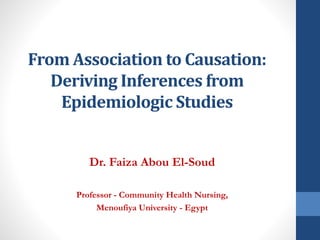
From association to causation
- 1. From Association to Causation: Deriving Inferences from Epidemiologic Studies Dr. Faiza Abou El-Soud Professor - Community Health Nursing, Menoufiya University - Egypt
- 2. I. Identify the approaches for studying diseases etiology II. Determine the ecologic studies III. Discuss type of association IV. Explain type of causal relationships
- 3. I. Approaches for Studying Diseases Etiology • Expose animals to risk factors such as carcinogens in control lab: – Control the exposure dose – Control other environmental conditions and genetic factors – Keep lost to follow-up to minimum • Can we conclude data across species and from animal to human population?
- 4. Approaches to Etiology in Human Population • build on unplanned or natural experiments – People exposed to risk for non-study purposes. e.g. exposure to atomic bomb radiation in Hiroshima and Nagasaki
- 5. Approaches to Etiology in Human Population •
- 6. Approaches to Etiology in Human Population Two steps process is followed in carrying out studies and evaluating evidence 1.Determining association between an exposure or characteristics and the risk of a disease • Studies of characteristics: ecological studies • Studies of characteristics: case control & cohort 2. If association exist - Determine whether the observed association is likely to be a causal one.
- 7. II. Determine the Ecologic Studies Example (1)
- 8. Ecologic studies : Interpretation • • the average dietary fat consumption for a country, the breast cancer incidence. • • No information on individuals (outcome - breast cancer . exposure - high dietary fat intake). • • Evaluate to members of a group, characteristics that they in fact do not possess as individuals (ecologic fallacy)
- 9. Ecologic studies : Homework Answer: “the observed association is between pregnancy during an influenza epidemic and subsequent leukemia in the offspring of that pregnancy. It is not known if the mothers of any of these children actually had influenza during their pregnancy”.
- 12. A. Type of Causal Relationships
- 13. A. Type of Causal Relationships (i)• Necessary and sufficient – Without that factor the diseases never develops, and in its presence the disease always develops. – This situation rarely occurred .
- 14. A. Type of Causal Relationships (ii)• Necessary, but not sufficient – Factor is necessary but not sufficient to produce the disease e.g. Tubercle bacillus – Multiple factors are required, often in a specific temporal sequence.
- 15. A. Type of Causal Relationships (iii)• Sufficient, but not necessary – The factor alone can produce the disease, but so can other factors. • Radiation, benzene – either can produce leukemia • Cancer does not develop in everyone who has experienced radiation or benzene exposure
- 16. A. Type of Causal Relationships (iii)• Neither sufficient nor necessary – More complex model – Probably most accurately represents the causal relationships that operate in most chronic diseases
- 17. Guidelines for Judging Whether an Association is Causal 1. Temporal relationship 2. Strength of association 3. Dose response relationship 4. Replication of findings 5. Biologic plausibility 6. Consideration of alternate explanations 7. Cessation of exposure 8. Consistency with other knowledge 9. Specificity of the association
- 18. Guidelines for Judging Whether an Association is Causal 1. Temporal relationship 2. Strength of association 3. Dose response relationship 4. Replication of findings 5. Biologic plausibility 6. Consideration of alternate explanations 7. Cessation of exposure 8. Consistency with other knowledge 9. Specificity of the association
- 19. 1.Temporal relationship • Exposure to the factor must occurred before the disease developed. • It is easy to establish a temporal relationship in a than in a and . • Length of the interval between the exposure and disease (asbestos in lung cancer).
- 21. 2. Strength of association • Strength of association is measured by - Relative Risk or - Odds Ratio. • The stronger the association, the more likely the relation is causal
- 22. 3. Dose response relationship • As the dose of exposure increase, the risk of disease also increases. • If a dose response relationship is present, it is strong evidence for a causal relationship. • Absence of dose response relationship rule out a causal relationship. • In some cases a threshold may exist
- 23. Figure: Dose response relationship
- 24. 4. Replication of findings • If the relationship is causal, we would to find it consistently in different studies and in different population. • It is expected to be present in subgroups of the population.
- 25. 5. Biologic plausibility • Coherence with the current body of biologic knowledge • Sometimes, epidemiological observation preceded biologic knowledge E.g. on Rubella and congenital cataracts preceded any knowledge of teratogenic viruses • If epidemiological findings are not consistent with the existing knowledge - interpreting the meaning of observed might be
- 26. 6. Consideration of alternate explanations • Explanation of a relationship as causal or due to confounding. • The extent to which the investigators have taken other possible explanations into account and the extent to which they have ruled out such explanations are important considerations.
- 27. 7. Cessation of exposure • If a is a cause of a diseases, the of the disease to decline when exposure to the factor is reduced or eliminated.
- 28. 8. Consistency with other knowledge • If a relationship is causal, we would the findings to be consistent with other data.
- 29. 9. Specificity of the association • An association is specific when only – The weakest point of the guideline – should be . – Smoking is linked with lung, pancreatic & bladder cancers; heart disease, emphysema … – When specificity of an association is found, it provides additional support for a causal inference – With a dose response relationship, absence of specificity in no way negates a causal relationship.
- 30. Thank You